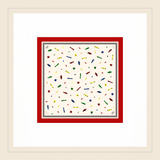AN ENTHUSIASTIC ILLUSTRATOR
Cradled by the sun and beaches of southeastern France, this young illustrator grew up with a head full of pop colors! Today, she lives in Paris, where the summer vibes of her childhood constantly influence her work and her good humor. After proving herself for other major brands, she enthusiastically welcomed a collaboration with Monoïkos 1297.
A note of history
The Monaco Grand Prix is one of the oldest and most prestigious races in the world.
Created in 1929 by Antony Noghès, the Monaco circuit, designed in the heart of the city, has retained almost its entire original layout, a narrow, winding track, making it one of the most demanding circuits on the Formula 1 World Championship calendar.
Monaco is the birthplace of pole position! Until 1933, starting grids were determined by drawing lots. But in Monaco, where it's difficult to overtake, this system wasn't very fair. Antony Noghès suggested that the best times be used to determine the starting grid, and that the first place should be on the right, on the front row.
The Monaco Grand Prix was also the first Grand Prix to officially adopt the chequered flag (inspired by the one used at Indianapolis) in 1934, and it was only three years later, in 1937, that this flag was incorporated into the AIACR international sporting code and became the universal symbol of victory.
The Monaco circuit measures 3.367 Km.
It starts at Port Hercule, then winds through the streets of Monte-Carlo and La Condamine, with a series of tight bends in the middle of guard rails: the track is narrow and demanding, making overtaking difficult.
After the start line, the drivers head up boulevard Albert Ier and squeeze into the first right-hand bend of “Sainte Dévote”, the scene of numerous clashes on the first lap. They then begin the steep climb up “Beau-Rivage” to the tight left-right of “Casino”. From there, the drivers descend to the “Mirabeau” right-hand bend, followed by the “Grand Hôtel” left-hand hairpin, the slowest bend in the championship. The “Portier” section then leads to the sea, and drivers pass through the tunnel that leads to the chicane near the port. As they exit the tunnel, the fastest section of the circuit, the single-seaters approach 300 km/h. After a short straight on the Quai des États-Unis, there's the left-hand turn at “Bureau de Tabac”, the left-right section at “La Piscine”, then a very difficult right-hand hairpin at “La Rascasse”. Finally, the drivers tackle the “Anthony Noghès” bend before the pit lane and the finish.
This is certainly one of the most demanding circuits on the Formula 1 World Championship calendar. It's the most glamorous, the most prestigious, the most popular and, above all, the Grand Prix that every driver and every team wants to win!
A pocket square of exception
A technological feat has been used to reveal the most delicate details and the most demanding patterns in color.the roulottage, a delicate Italian-style hem, is handmade. the box, its case, red, the color of Monaco, is made in the Principality from FSC-certified paper from responsibly managed forests.
The “Les Courses à Monaco” pouch is part of the “Grand Prix” collection, a 100% silk pouch illustrating a major event in the Principality of Monaco.
The silk
Ce précieux filament brillant, obtenu en dévidant le cocon d’un ver à soie, requiert naturellement des conditions de production de très haute qualité.
Très sensible à la qualité de l’environnement, le ver à soie ne supporte pas la pollution et ne se nourrit que de feuilles fraîches.
Son élevage exige un savoir-faire d’excellence : nos artisans ont sélectionné les meilleures fermes séricicoles.
Préservez la beauté de votre pochette en soie :
- Conservez-la à plat ou dans sa boîte d’origine.
- Évitez le contact avec votre parfum.
- Confiez le nettoyage à un professionnel spécialisé.





